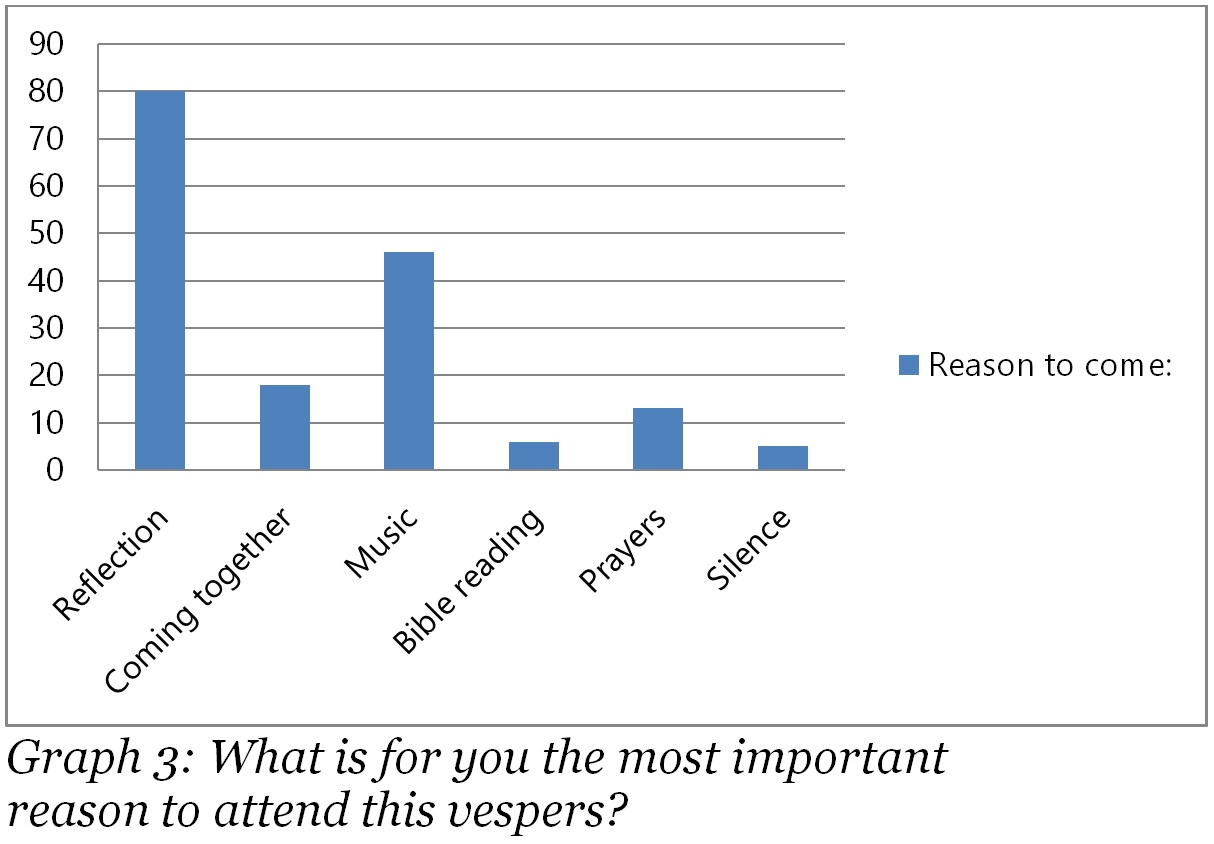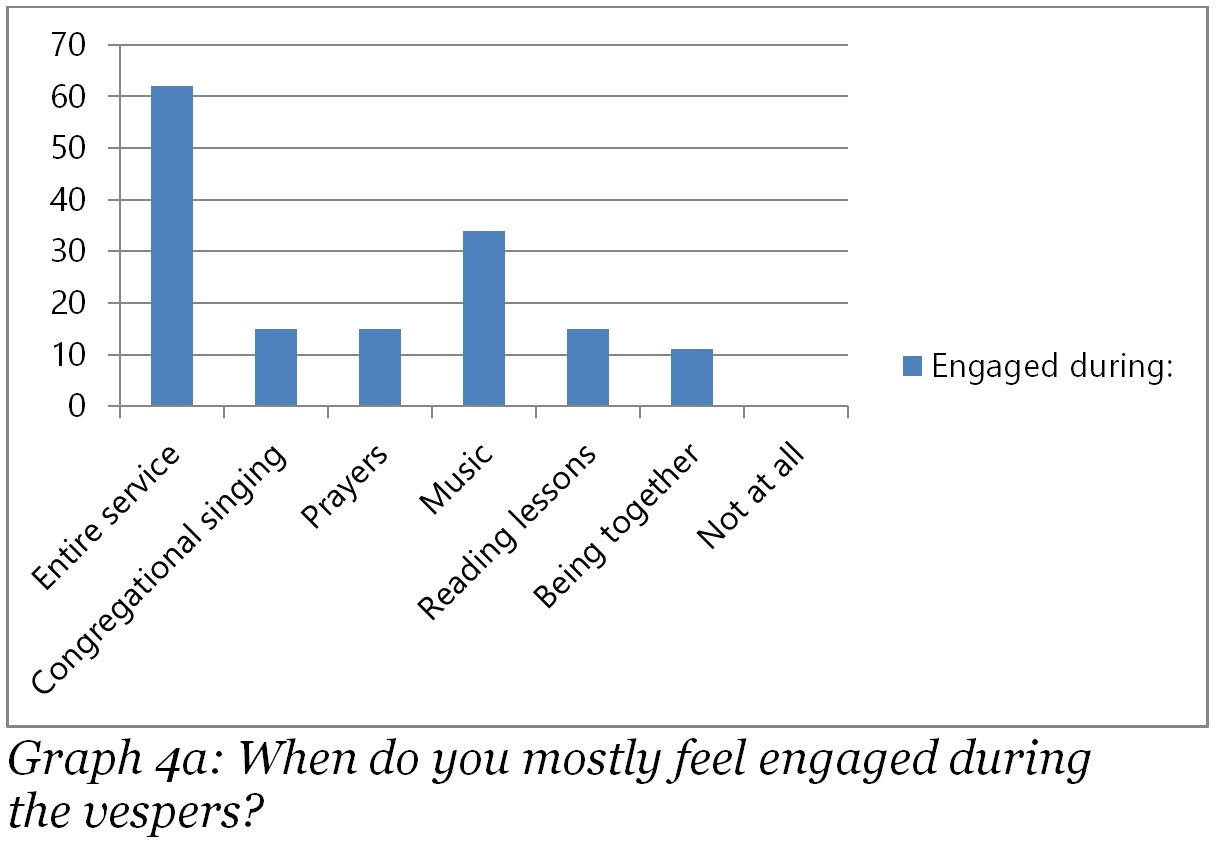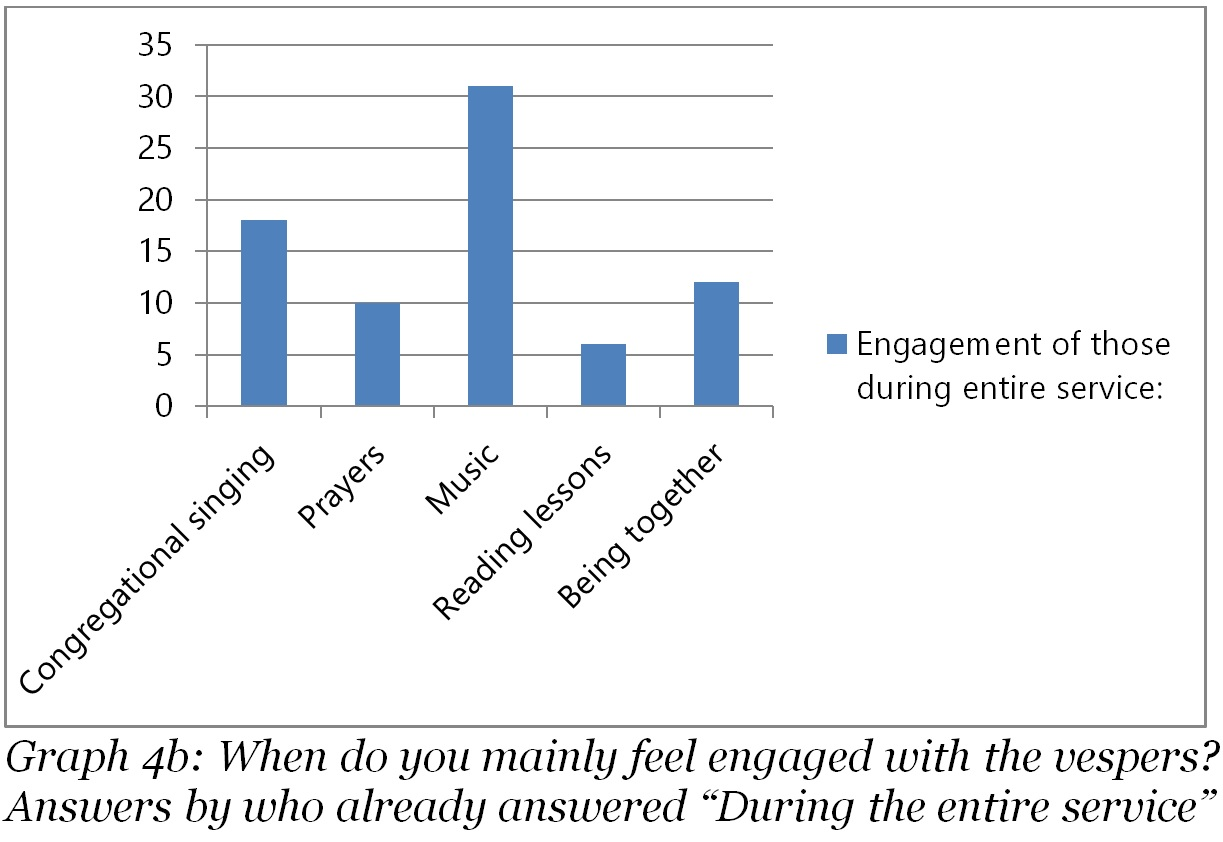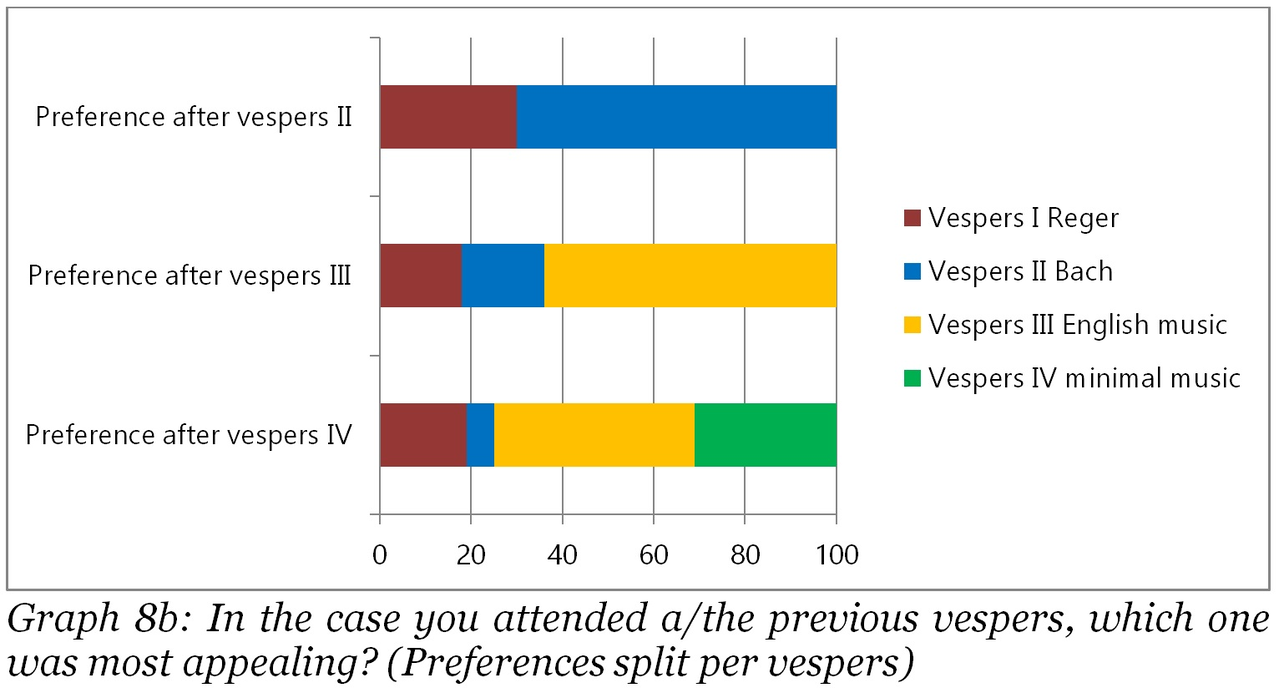IV. Analysis
Questionnaire
To study the appreciation of the organ vesper and the specific role of the (different) music in these vespers, a survey was conducted amongst the visitors. The four organ vespers were relatively well attended, with more or less 25-35 people per vesper. The number of visitors was in line of what could be expected as regular Sunday morning services have more or less 70-100 attendants and these vespers mainly appeal to congregants who appreciate a moment of reflection and music. Furthermore, the youngest and oldest members of the church community are less likely to visit a service on a Wednesday evening. In order to map why people visited the organ vespers, how they were engaged with the organ vespers, and how they experienced the different kinds of music, the attendants were asked to fill in a questionnaire survey of eight questions. The attendees were invited to answers the questions after each vesper, which most likely has resulted in questionnaires answered by recurrent visitors. In total 82 completed questionnaires were filled in during those four vespers. The division of the respondents over the four vespers is respectively 27, 16, 22 and 17. It provides a valuable insight in the motivations and experiences of the attendants. In the following paragraphs, the results of this questionnaire will be discussed.
Background of respondents
(Note: see all mentioned graphs in the slideshow on the right)
Graph 1: How did you know about this organ vespers?
Question 1 asked how people came to know about the organ vespers they visited. There were four answer categories listed, namely that people were informed about the organ vespers through the weekly newsletter Zondagsbrief, through the monthly church magazine Onderweg, via Facebook, or in another way. As shown in graph 1, most people knew about the vespers through the weekly newsletter. When looking into the answers provided on the ‘other’ option, most people explained that they heard about the vespers directly from the author of this research. This shows that the attendants were mostly from the Goede Herderkerk since they read the Zondagsbrief, and/or were personally known to the researcher.
Graph 2: Are you (denominationally) involved in the Goede Herderkerk?
The results on the second question further support the hypothesis that most attendants are engaged with the Goede Herderkerk. As mentioned before, the first vespers was combined with a lecture on the music of Max Reger. The vespers was effectively a prelude to the lecture, since, by design, it included music by Reger. People who came for the lecture and therefore attended the vespers were in part congregation members and in part organ music lovers in general. This explains why 35% of the people at the first vespers answered that they were not involved in the Goede Herderkerk, which is considerably more than the 6-14% in the other three vespers. In sum, the answers to the first two questions demonstrate that a large majority of the attending people are congregants in the Goede Herderkerk.
Motivation and engagement
Graph 3: What is for you the most important reason to attend this vespers?
Since many of the attendants at the organ vespers are involved in the Goede Herderkerk, this might be a cause for response bias, for congregants are likely to have visited more than one of the four vespers. That means that people who attended all vespers are likely to have provided four times the same answer to the question of why they came to the vespers. With that in mind, a general pattern in the motivation of people can still be analyzed. As graph 3 illustrates, the main reason to attend an organ vespers is that it offers a moment of reflection. The second most mentioned reason is the music, which is not surprising, because the vespers were specifically announced as organ vespers. People knew what they came for, and since music was an important element of the vespers, that was a logical motivation for attending. This result is a small confirmation of the hypothesis that music is an important reason to attend services. To complete the picture arising from this question: 18% answered “coming together” and 13% said to come for (among others) saying prayers.
Graph 4a: When do you mostly feel engaged during the vespers?
Graph 4b: When do you mainly feel engaged with the vespers? (Answers by those who already answered “during the entire service”, but also marked specific parts of the vespers.)
When asked during which part of the vespers people felt engaged, 62% answered “during the entire service” (see graph 4a). This implies that the people felt engaged in the whole of the vespers, but might also be seen as a positive review of the vespers in general. Amongst those that also indicated specific elements of the vespers during which they felt most engagement, 34% indicated that music contributed to this feeling of participation (see graph 4b). This directly relates the organ playing to the involvement of the attendants. It must be noted that this answer does not mean that 66% did not feel engaged during the music, as this was not an agree-or-disagree question, but a multiple response question. It can thus be concluded that most attendees felt connected throughout the entire vesper, and that music was one of the key elements noted by those that did not indicate an overall involvement. This rather firmly confirms the hypothesis that music is indeed a reason to come to church.
Graph 5: How could the vespers be improved to answer your expectations better?
The fifth question asked how the vespers could be improved to better address the attendant’s expectations. Opinions on whether there should be less or more prayer, music, lesson reading, singing and silence could be given on a five-level Likert scale. No one answered the first level “much less” to any of the five components of the vespers, so graph 5 below only presents the four levels “less”, “neutral”, “more” and “much more”.
The results can be interpreted in two ways. In the first place, the 54% that would like to enjoy more or much more music in the vespers might imply that the sample group consists of many music lovers or people that specifically came for the music in the organ vespers. In the second place, this high percentage of people wanting more or much more music in the vespers might be understood as a positive review of the music they had just enjoyed in the vespers. In addition to that, it must be considered that the sample group was informed about the research project of the organist and might thus be inclined to positively highlight the element of music in the questionnaire.
Nonetheless, the results in graph 5 do correspond to the general pattern as seen in the previous graphs. “Music” is most often mentioned as the reason to attend the vespers, as part of the vespers during which people felt most engaged with the vespers, and as component that they cannot have enough of. Just as in graph 4b, “singing” comes second, now with 30% answering to desire more singing and 10% much more singing.
The role of music in the organ vespers
Graph 6: Do you agree or disagree with the following statements?
The first five questions were aimed at mapping the background of the attendants and their motivations and engagement in general. The sixth question focused specifically on the role of the music in the vesper, by posing five statements that people could agree or disagree with. The vast majority of the people agreed with the first three statements, once more confirming how the attendants valued the music in the vespers. It was seen as an important and well integrated part of the service. Once again it must be stressed that it is probable that the group sampled treasured music and came in part for the music to the organ vespers. Still, the numbers overwhelmingly confirm the added value of music in the vespers.
The fourth statement that the music invites the people to reflect on the texts, readings, and prayers in the vespers has a slightly different response. Even though the majority (89%) agreed with the statement, a larger proportion than the previous statements disagreed with the statement that the music invited to reflection 89% agreed and 11% disagreed with the idea that music invites to reflect on the vespers. The fifth statement showed an even larger disagreement between those answering the questionnaire. In general, 58% of the visitors indicated that they would not have visited the vesper without a special focus on the music. The statement posing that the respondent would also have come to the vespers if there was no special attention to music was positively answered by 42%. 58% said not to come to a vespers without special attention for music. That means that the music was a triggering factor to come to the vespers for a small majority of the respondents. This result rather specifically underlines the added value of (organ) music in a liturgical context and this research’s hypothesis that music is an force of attraction of churches.
The four organ vespers compared
The seventh question asked the respondents to describe the music in the vespers. The results are split into the answers per vespers, in order to make a comparison with the reactions on the different styles of organ music in the different vespers possible. The separation of results, however, means that the sample group of respondents per graph is much smaller than the entire group of 82 respondents on which most of the previous graphs were based. The division of the respondents over the four vespers is respectively 27, 16, 22 and 17.
Graph 7a-d: How would you describe the music in this vespers? (Vespers I-IV)
It is striking how the music was experienced as meditative by respectively 93%, 100%, 91% and 88% of the respondents. This outcome matches well with the 80% of the people who mentioned “reflection” as reason to join the vespers, and can be explained by two factors. First, the setting of a vespers itself might be described as meditative. As became clear in chapter II, vespers typically focus on stillness, prayer and reflection. The vespers studied were held in the dark evenings of November and December. There was silence in the beginning, middle and end of the vespers and evening hymns were sung, which all contributed to a subdued and quiet atmosphere. The second factor is a result of the first, for the music chosen for the organ vespers as type of evening prayer is logically meditative in nature. All organ pieces were rather subdued, with moderate tempi and performed with only a handful of registers. Following the observations and guidelines as mentioned in chapter II, the music was meant to offer reflection. The fact that the music in all vespers was described as meditative by a large majority can thus be explained both by the setting of the vespers as well as the purposely meditative character of the selected pieces of music.
The results in the four graphs are not as distinctive as the researcher had hoped for, which makes it difficult to draw conclusions on the qualities and characteristics of the different styles of music in these four organ vespers. For all vespers however, it should be noted that respondents only described the music in a positive manner, not once was the music described by negative emotions (grave or boring).
Graph 8a: In the case you attended a/the previous vespers, which one did you find most appealing? (Overall preferences)
The final question asked the respondents to directly compare how attractive they found the current vesper compared to earlier editions. The answers to this question are prone to response bias for two reasons. First, the attendants at the second vespers were only able to compare the first two, and the respondents of the third vespers only the first three. Secondly, those who were at, for example, the fourth vespers may not have necessarily attended all four vespers, so their comparison might have been incomplete. Nonetheless, a general overview of all vespers presented in graph 8a shows a clear preference for the third vesper.
Graph 8b: In the case you attended a/the previous vespers, which one was most appealing? (Preferences split per vespers.)
If the answers to this question are split by vespers, one can compare the appeal of the vespers after the first two, first three and first four vespers. The first vespers alone is self-evidently irrelevant for a comparison. As graph 8b demonstrates, 70% preferred the Bach vespers over the Reger vespers after these first two vespers. After the third vespers, both the Reger and Bach vespers were found most appealing by 18% each, while 64% preferred the vespers with English music. After the last vespers, 44% preferred the English vesper, compared to 19% for the Reger vespers, 6% for the Bach vespers and 31% for vespers IV with minimal music.
The sample size for the split vespers results is even smaller than in case of the question that asks the attendants to describe the music in the vespers, because not every respondent answered the last question. Furthermore, it must be noted that a couple of respondents added that their choice was not solely based on the music in the vespers, but also because the later vesper(s) were more serene and better organized than the first vesper(s). The researcher recognizes these comments, as the vespers were a newly introduced format and he also noted a gradual improvement of the organization over time.
The fact that the vesper with a focus on English music was preferred by most visitors might be explained by the relation of this vesper to the tradition of Anglican evensong. In the first place, the evensong has a well-known tradition of high level music and performances, and inspired many composers to compose appropriate music, as explained in chapter I of this research. In the second place, the Anglican evensong finds its way more and more to the Protestant Church in the Netherlands. It is an increasingly popular format of evening prayer and music, and an organ vespers with English music connects to this tradition and music. The intention and sphere of the music relates well to the format of an organ vespers, and invites one to further explore the organ vespers and the repertoire of English music to use it for the purpose of offering a liturgical moment of reflection with music as special feature.













